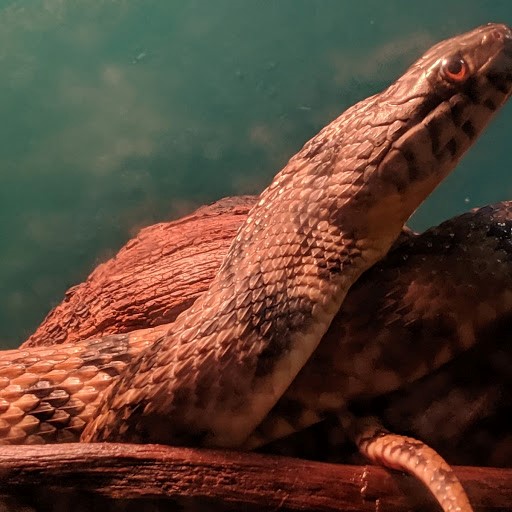by M. Kathy Raines

Relax, it’s not a cottonmouth. Those venomous water snakes, you’ll be pleased to know, live no further south than Corpus Christi.
No, that long, thick, brownish snake swimming in or basking along a Rio Grande Valley resaca is likely one of our benign and quite plentiful diamondback water snakes (Nerodia rhombife)—and no close kin to an infamous diamondback (Crotalus atrox).
Though Texas is indeed home to several venomous snakes—including cottonmouths, also called water moccasins, and copperheads—only coral snakes and rattlers live in South Texas.
Snakes, if posing no immediate danger, should be left alone. Still, lest one panic and bludgeon a poor, harmless water snake, here are a few noteworthy differences. A cottonmouth swims with its head above water, its body visible, unlike a diamondback water snake, whose head is nearly submerged, with its body well underwater. While the cottonmouth’s pupils are vertical slits, the diamondback has round ones. Also, the cottonmouth’s head is somewhat V-shaped, its neck appearing thin in comparison, while the diamondback’s is more rounded—though when aroused, it may appear more angular. Also, only the cottonmouth, being a pit viper, has heat-sensing pits between its eyes and nostrils.
The diamondback water snake, one of ten nonvenomous Texas water snakes, bears a diamond-shaped pattern on its back, usually with dark bars and lighter colors along its side; its underside is yellow or light brown with dark blotches. It may be coated with algae or silt, hindering clear identification. The longest U.S. water snake, adults average about five feet in length, with some reaching lengths of about eight feet. Females are larger, heavier and faster growing.
The diamondback often loops around and dangles from branches along water, dipping its head, searching for prey. If approached, it drops into the water and swims off. Rather lethargic, it is not up to catching the speedy, lively game anglers relish, so these snakes do not offer them much competition. However, it may steal fish from a stringer, and an astonished angler occasionally reels up a snake latched onto a hook. Apparently, cottonmouths do not behave thusly.
Even in murky water, this serpent may swim, sweeping its head from side-to-side, mouth agape, through schools of fish, until it snaps one up. The snake also forages in grasslands near water. Primarily a diurnal predator, it may hunt at night during hot summers. Its prey, dependent upon habitat, includes frogs, small mammals, animal carcasses and a variety of fish—even catfish, whose spines sometimes perforate its hide.
Though it shies from confrontations, if cornered, this snake will hiss and bite energetically, sometimes inflicting a painful wound that bleeds profusely—possibly an adaptation that helps it follow a blood trail to detect wounded, escaped prey.
Generally solitary except when mating, these snakes may hibernate in an underground group in temperate climates.
Male diamondbacks may congregate in a breeding ball—not fighting, but vying to mate with a female. A pair selects a spot for copulation, often a bank or overhanging limb. The couple rolls around, locked for an hour or longer. These ovoviviparous (live-bearing) snakes produce about 50 young, after a gestation of between 3 to 5 months, between August and mid-October. However, one April afternoon I saw about fifteen diamondbacks, mostly small ones, swimming in the Arroyo Colorado in Harlingen’s Ramsey Park. Breeding schedules, said Clint Guadiana, Curator of Reptiles and Amphibians at the Gladys Porter Zoo, can vary with changes in weather; even snakes housed indoors appear to sense variations in barometric pressure.
Few covet these water snakes as pets. For one thing, their feces is runny and malodorous, since they eat frogs and fish, said Guadiana. Also, besides being fierce biters, he said, they have an “extraordinary musking ability”; when threatened, they emit an extremely foul substance whose odor may take days to get rid of. Then there’s their combativeness. Nevertheless, a young snake may become rather docile when handled regularly.
Two Youtube videos, “Man Hand Feeds Water Snake” and “Feeding Time”, feature a man standing on a dock holding a fish, with a diamondback swimming up and snatching it out of his hand. In the first, the snake initially bites the man’s pants leg; the man, owning his error, says, “I rubbed the scent of the fish on my leg.”
Though large, diamondback water snakes are not apex hunters. Opossums, raccoons, foxes, other snakes and turtles prey on them, and frogs, snakes, mammals and birds devour the young.
Diamondback water snakes are thriving despite human encroachment, which Guadiana thinks is partly due to their fierce attitude and high reproduction rate. Unfortunately, some people kill these creatures, mistaking them, with their patterned skin and combative nature, for venomous snakes.
These snakes benefit us by devouring harmful rodents, debilitated and dead creatures, and, in some places, invasive bullfrogs that threaten endangered frogs. They also keep fish populations in check, including invasive carp and tilapia.
Preferring slow-moving water, diamondbacks inhabit a variety of waterways: ponds, swamps, rivers, drainage ditches and stock tanks. The most common water snake of the coastal plains south of Houston, the diamondback water snake populates several states in the Midwest and South and northern Mexico. They inhabit most of Texas to the Edwards Plateau, but excluding the Great Plains and Trans-Pecos region.

